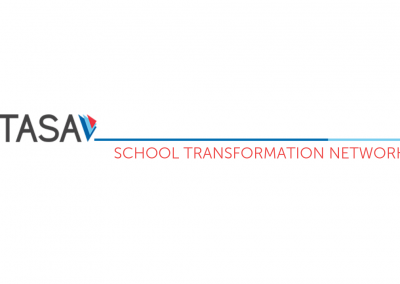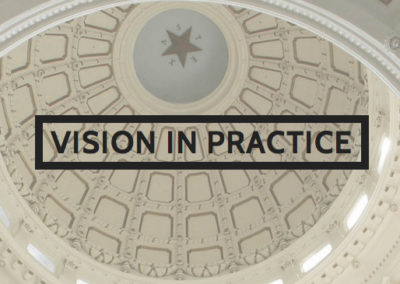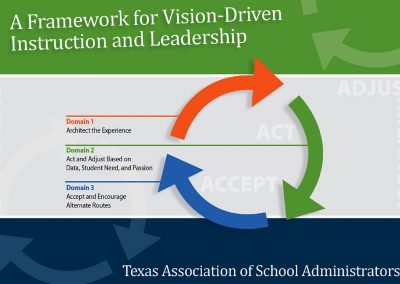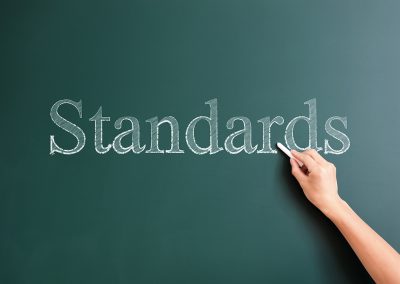What are high-priority learning standards?
High‐priority learning standards should be:
- Reflective of current research in the area of college and career readiness (ACT, SAT, AP, IB, etc.)
- Reflective of national and international standards
- Inclusive of the essential core knowledge and processes of each discipline
- Clear and rigorous
- Manageable in number
The Texas High Performance Schools Consortium has designed a process for determining high-priority learning standards that emphasize depth over breadth and empower students to learn, live, and earn in a global and digital environment and recommended both short- and long-term strategies for developing such standards.
The Process for Determining HPLS
Prioritize and focus on what matters most. Students learn more when we teach what is most important and we teach it well. High-priority learning standards are fewer and deeper as opposed to a mile wide and an inch deep. Typical state standards attempt to cover a content area so comprehensively, the essential concepts that produce deep mastery can become lost. The chief problem is that there is simply too much to teach — arguably two to three times too much — and too many options for what can be taught. Rather than presenting a long list of facts, standards should communicate the essential understandings and habits of practice within each subject area.
Content, thinking, and skills all matter when it comes to standards design. To succeed in today’s workplace, young people need more than basic reading and math skills. They need deep knowledge of content and ease with information technology, honed problem-solving skills and the ability to adapt and change. They need the personal skills to work in a very diverse and multicultural environment and the ability to collaborate.
Align standards with best evidence on college and career readiness. U.S. executives say they need a workforce equipped with skills beyond the traditional “three Rs” of reading, writing, and arithmetic if they are to grow their businesses in the 21st century. According to the American Management Association, today’s employees need to think critically, solve problems, innovate, collaborate, and communicate more effectively.
Recognize that standards design influences assessment design, assessment design influences instruction, and instructional decisions determine the level and type of learning opportunities provided to students. Standards-based assessments influence both what teachers teach and how they teach it. Educators must be deliberate about the number of standards they assess. Too many assessed standards forces teachers to push through the curriculum, covering standards rapidly and superficially. Standards-based assessments should help teachers make good decisions about their instruction and promote the design of learning opportunities that drive students to deeper learning and mastery.
Proposed Strategy
Short-term Solutions
- Test readiness standards only.*
- Include more test items per standard.
Long-term Solutions
- Develop/prioritize/coalesce high-quality, fewer, deeper learning standards designed in accord with future-ready learning, college/career readiness, and expectations of the global workplace.
- Establish assessment expectations that rely less on multiple-choice items and more on rigorous, performance tasks.
- Reduce the number of tested grade levels and/or standards.
- Allow for stratified random sampling of students to accommodate the complexity and cost of administering and scoring performance tasks.
*Cannot be applied as a long-term strategy due to the progressive, interconnected nature of PK-12 learning standards
The Vision: High-Priority Learning Standards
Article II: The New Learning Standards
Supporting Premises
- Standards should be clear, attainable, and high enough to provide for a system of student performance variance where all can experience success and challenge.
- Learning should be specified to the “profound level,” that is, students are able to apply their learning to new situations, to synthesize, solve problems, create knowledge, and cultivate and utilize the full range of their capabilities.
- Learning standards should embrace development of the whole person to build students’ capacity to shape their own destiny as individuals and as contributing members of society.
- Standards should respect and value students’ “multiple intelligences” and talents and provide opportunities for all students to excel and experience success.
- Standards should tap curiosity and imagination in the traditional academic core, aesthetic, and skill areas in a way that lack of proficiency in any one area does not discourage students from recognizing and pursuing their special talents and learning in other areas.
- New learning standards should reflect realities of the new digital era, where students are not just consumers of knowledge, but creators of knowledge.
- Content standards should serve as frameworks that assist teachers and students in creating learning experiences that motivate student success.
- Standards should be flexible enough to provide for expansion and extension by local districts and their communities.
- Guidance should be given to teachers’ daily work so they can make the content standards clear and compelling to their students for each unit of focus.
- Standards should be framed so they do not sacrifice the profound learning desired for easy and low-cost state assessment and accountability measures.
- When competent, caring teachers provide properly designed learning experiences in inspiring social environments, all students will engage and can meet or exceed a reasonable variance to the standards.
- Standards should result in all students being committed and equipped to be competent lifetime learners, well-prepared for further formal education and to pursue multiple careers.






